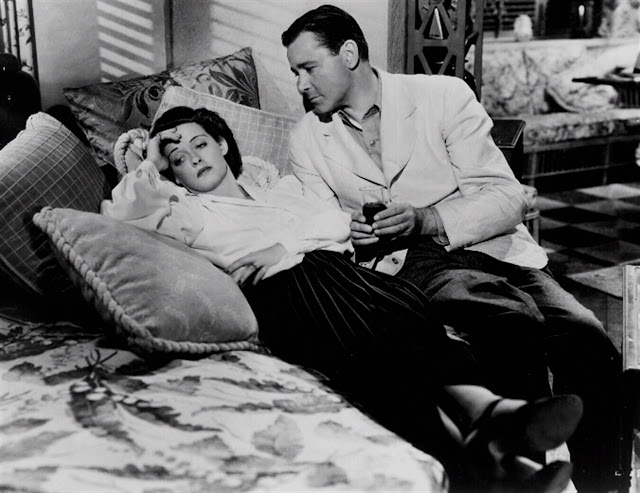William Wyler directed this American crime drama starring Bette Davis, guiding her into her third of five consecutive Academy Award nominations, a record only matched later by Greer Garson. Watching The Letter, and comparing it to the 1929 adaptation, it becomes clear that the Hays Code necessitated several alterations to the plot to satisfy their censorship rules. The film, after all, deals with infidelity and murder, two subjects that Hays insisted could not go unpunished. In the 1929 film, Leslie Crosbie is portrayed by Jeanne Eagles, a silent film actress who was also nominated for the Oscar for playing this character.
In that earlier version of the film, Leslie’s story ends with her confession that she still loves the man that she has killed. Wyler’s version, as required by the Hays Code, had to have punishment meted out. The solution is far more satisfying than the earlier film, but it came with a caveat: the ones who mete out the punishment, thanks to the code, also had to be punished for taking the law into their own hands. In a way, it lessons the impact of their actions and, while it could seem like poetic justice or irony, it ends the film on a slightly less effective note.
We open the film with a murder. A man is seen leaving a woman’s home in Singapore, and a second later, Leslie (Bette Davis) follows him with a gun in her hand. She shoots him multiple times, including after he has fallen to the ground. When the police arrive, she tells them that he tried to force himself on her, and she defended herself. This story satisfies the authorities, but she still must be taken in until the details can be sorted through and her innocence confirmed. Alas, there is just one problem with her story: a letter exists that she sent to the murdered man, begging him to come to her that night. The widow of the murdered man is in possession of this incriminating evidence and sends word, through an emissary, to Leslie’s lawyer that the letter can be acquired for the sum of $10,000, an amount that her husband, Robert (Herbert Marshall), barely has in their savings.
While this is in some effect a murder mystery, the details are revealed fairly early on in the plot. And while Bette Davis is giving her usual scene-stealing performance, her presence very early on dispels any thought that she might be innocent. She is trying to play it coy, but there is a steely look in her eyes that betrays the anger just beneath the surface. We see it as she is callously firing the gun into her victim’s back, and we see it even more pronounced later when told that this letter not only has been found but is being used to blackmail her. Gone, at that point, is any pretense of innocence, and now we wonder instead why she actually shot him.
And that is a question that largely goes unanswered. We learn that the relationship between Leslie and the victim, Geoffrey Hammond, had been growing cold, and that was a contributing factor in the argument that led to his death. We also learn that Leslie, even after killing him, still loves him, something that devastates her husband when he finds out. It is that revelation that ends the original film, leaving us with feelings of uncertainty and disdain for her. But that is not a satisfying ending, especially for those who feel that Leslie should ultimately be held responsible for her actions. That ending is just a little too ambiguous.
The resolution used in the 1940s film is more concrete, yet it has its own problems. Mr. Hammond’s widow demands $10,000 in exchange for the letter. She also, secretly, wants Leslie to pay the ultimate price and, after the trial is over and Leslie is found innocent, arranges to take her own revenge on the woman. Presumably, her plan was to pocket the money and later kill Leslie should the courts not convict. A modern-day film would spell this out better while allowing the widow her revenge. But the Hays Office could not allow the widow to get away with murder any more than Leslie. This creates the necessity for the widow, and her accomplice, to also be caught and arrested. It muddles up the ending and leaves it on a note of disappointment.
Bette Davis has a reputation for playing villainesses. This is primarily because she is so good at chewing the scenery. But she is also good at the quiet moments where you have to pay attention to her face to get what is going on with her character. She spends a lot of time knitting and just listening in on conversations. We get her state of mind, though, as news that affects her directly comes to her attention. We also get the desperation she feels even as she is trying to come across as steely. Her violent nature and her insecurities are all on display, painting the portrait of a woman who is at all times conflicted yet resolved. She is the main character in this story, but by design, we are not meant to empathize with her. It was her own infidelities and need for attention that led to her violent actions, and when justice is ultimately meted out, it is deserving.
So much of this film is dependent on Bette Davis’ ability to keep us with her even when we cannot root for her. This is different from her role in The Little Foxes, also co-starring Herbert Marshall. In that film, we are actively against her because there is the daughter character that we can latch on to. That is not the case in The Letter. In this film, all we have is Bette Davis, and it leaves us conflicted on how we feel about her. We don’t get enough about her relationship with her husband to make much of a judgement about him. Ultimately, we cannot be on her side; that is the brilliance of this script. We don’t outright hate her, but we don’t sympathize with her either. It’s a moralizing story, even though that moral does gets a little muddled in the conclusion.
Academy Award Nominations:
Outstanding Production: Hal B. Wallis
Best Director: William Wyler
Best Actress: Bette Davis
Best Supporting Actor: James Stephenson
Best Cinematography - Black-and-White: Tony Gaudio
Best Film Editing: Warren Low
Best Original Score: Max Steiner
____________________________________________________
Release Date: November 22, 1940
Running Time: 95 Minutes
Not Rated
Starring: Bette Davis, Herbert Marshall, and James Stephenson
Directed By: William Wyler










Comments
Post a Comment